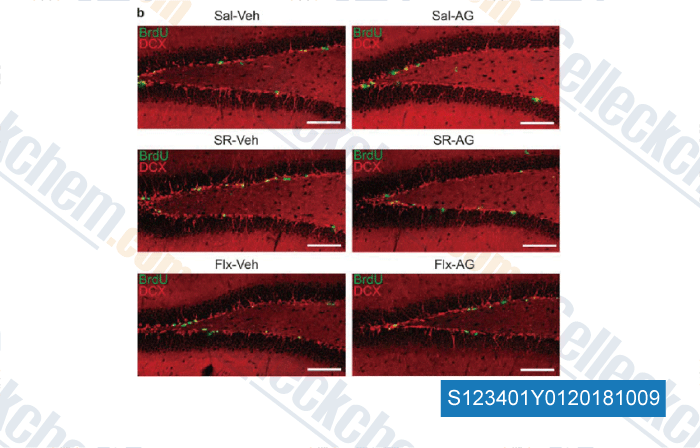|
Toll Free: (877) 796-6397 -- USA and Canada only -- |
Fax: +1-832-582-8590 Orders: +1-832-582-8158 |
Tech Support: +1-832-582-8158 Ext:3 Please provide your Order Number in the email. |
Technical Data
| Formula | C14H13BrN2O |
||||||||||
| Molecular Weight | 305.17 | CAS No. | 65678-07-1 | ||||||||
| Solubility (25°C)* | In vitro | DMSO | 61 mg/mL (199.88 mM) | ||||||||
| Water | Insoluble | ||||||||||
| Ethanol | Insoluble | ||||||||||
| In vivo (Add solvents to the product individually and in order) |
|
||||||||||
|
* <1 mg/ml means slightly soluble or insoluble. * Please note that Selleck tests the solubility of all compounds in-house, and the actual solubility may differ slightly from published values. This is normal and is due to slight batch-to-batch variations. * Room temperature shipping (Stability testing shows this product can be shipped without any cooling measures.) |
|||||||||||
Preparing Stock Solutions
Biological Activity
| Description | AG-1024 (Tyrphostin, AGS 200) inhibits IGF-1R autophosphorylation with IC50 of 7 μM, is less potent to IR with IC50 of 57 μM and specifically distinguishes between InsR and IGF-1R (as compared to other tyrphostins). | ||||
|---|---|---|---|---|---|
| Targets |
|
||||
| In vitro | AG-1024 blocks the IGF-1 receptor and IR autophosphorylation with IC50 of 7 μM and 57 μM, respectively. AG-1024 also inhibits the receptor tyrosine kinase activity towards exogenous substrates (TKA) with IC50 values of 18 μM and 80 μM, respectively. [1] AG-1024 (10 μM) inhibits cell proliferation in a time-dependent manner, and induces apoptosis in MCF-7 cells at 48 hours by 20.1% and >40% when combined with irradiation (10 Gy), more potently than that of irradiation (10 Gy) alone by 11.8%, which is associated with a down-regulation of phospho-Akt1 and bcl-2, and up-regulation of Bax, p53 and p21. [2] AG-1024 significantly inhibits melanoma cell proliferation with an IC50 of <50 nM in the absence of serum, by blocking MAPK/ERK2 signaling, subsequently rapidly inducing pRb dephosphorylation and activation, and eventually the formation of growth suppressive pRb-E2F complexes. [3] AG-1024 treatment down-regulates the expression of Bcr-Abl and P-Akt, and up-regulates DNA-PKcs expression in UT7-9 and Ba/F3-p210 cells, leading to decreased clonogenic survival and proliferation. AG-1024 also significantly inhibits the proliferation of cells resistant to the BCR-ABL inhibitor STI571, which correlates with a dose-dependent decrease in Bcr-Abl protein expression. [4] | ||||
| In vivo | Administration of AG-1024 at a dose of 30 μg for 10 days significantly inhibits the tumor growth of Ba/F3-p210 xenograft in mice. [4] |
Protocol (from reference)
| Kinase Assay:[1] |
|
|---|---|
| Cell Assay:[2] |
|
| Animal Study:[4] |
|
References
|
Customer Product Validation

-
Data from [ Blood , 2013 , 122(9), 1621-33 ]

-
Data from [ Mol Endocrinol , 2011 , 25, 2041-53 ]

-
Data from [ , , Mol Psychiatry, 2018, 23(4):833-842 ]
Selleck's AG-1024 Has Been Cited by 27 Publications
| A Transcriptomics Analysis of the Regulation of Lens Fiber Cell Differentiation in the Absence of FGFRs and PTEN [ Cells, 2024, 13(14)1222] | PubMed: 39056803 |
| LTK and ALK promote neuronal polarity and cortical migration by inhibiting IGF1R activity [ EMBO Rep, 2023, 24(7):e56937] | PubMed: 37291945 |
| Ras-mutant cancers are sensitive to small molecule inhibition of V-type ATPases in mice [ Nat Biotechnol, 2022, 10.1038/s41587-022-01386-z] | PubMed: 35879364 |
| Tyrphostin AG1024 Suppresses Coronaviral Replication by Downregulating JAK1 via an IR/IGF-1R Independent Proteolysis Mediated by Ndfip1/2_NEDD4-like E3 Ligase Itch [ Pharmaceuticals (Basel), 2022, 15(2)241] | PubMed: 35215353 |
| Targeting oncogenic mutations in colorectal cancer using cryptotanshinone [ PLoS One, 2021, 16(2):e0247190] | PubMed: 33596259 |
| Regulation of Hippo-YAP Signaling by Insulin-Like Growth factor-1 Receptor in the Tumorigenesis of Diffuse Large B-cell Lymphoma [ J Hematol Oncol, 2020, 13(1):77] | PubMed: 32546241 |
| Myeloid cells provide critical support for T-ALL in vivo [ The University of Texas at Austin, 2020, ] | PubMed: None |
| An Autocrine IL-6/IGF-1R Loop Mediates EMT and Promotes Tumor Growth in Non-small Cell Lung Cancer. [ Int J Biol Sci, 2019, 15(9):1882-1891] | PubMed: 31523190 |
| mTORC2-mediated PDHE1α nuclear translocation links EBV-LMP1 reprogrammed glucose metabolism to cancer metastasis in nasopharyngeal carcinoma. [ Oncogene, 2019, 38(24):4669-4684] | PubMed: 30745576 |
| A novel 5HT3 receptor–IGF1 mechanism distinct from SSRI-induced antidepressant effects [Kondo M, et al. Mol Psychiatry, 2018, 23(4):833-842] | PubMed: 28439104 |
RETURN POLICY
Selleck Chemical’s Unconditional Return Policy ensures a smooth online shopping experience for our customers. If you are in any way unsatisfied with your purchase, you may return any item(s) within 7 days of receiving it. In the event of product quality issues, either protocol related or product related problems, you may return any item(s) within 365 days from the original purchase date. Please follow the instructions below when returning products.
SHIPPING AND STORAGE
Selleck products are transported at room temperature. If you receive the product at room temperature, please rest assured, the Selleck Quality Inspection Department has conducted experiments to verify that the normal temperature placement of one month will not affect the biological activity of powder products. After collecting, please store the product according to the requirements described in the datasheet. Most Selleck products are stable under the recommended conditions.
NOT FOR HUMAN, VETERINARY DIAGNOSTIC OR THERAPEUTIC USE.
